Factors Affecting the Formation of 2:1 Host:Guest Inclusion Complexes of 2-[(R-Phenyl)amine]-1,4-naphthalenediones (PAN) in β- and γ-Cyclodextrins
Abstract
:1. Introduction
2. Results
2.1. Electrospray Ionization Mass Spectroscopy (ESI-MS) Studies
2.2. Molecular Modeling Studies
3. Discussion
4. Materials and Methods
5. Conclusions
Acknowledgments
Author Contributions
Conflicts of Interest
References
- Szejtli, J. Introduction and general overview of cyclodextrin chemistry. Chem. Rev. 1998, 98, 1743–1753. [Google Scholar] [CrossRef] [PubMed]
- Del Valle, E.M.M. Cyclodextrins and their uses: A review. Proc. Biochem. 2004, 39, 1033–1046. [Google Scholar] [CrossRef]
- Crini, G. Review: A history of cyclodextrins. Chem. Rev. 2014, 114, 10940–10975. [Google Scholar] [CrossRef] [PubMed]
- Süle, A.; Szente, L.; Csempesz, F. Enhancement of drug solubility in supramolecular and colloidal systems. J. Pharm. Sci. 2009, 98, 484–494. [Google Scholar] [CrossRef] [PubMed]
- Wagner, B.D. The effects of cyclodextrins on guest fluorescence. In Cyclodextrin Photochemistry, Photophysics and Photobiology; Douhal, A., Ed.; Elsevier B.V.: Amsterdam, The Netherlands, 2006; pp. 27–59. [Google Scholar]
- Marques, H.M.C. A review on cyclodextrin encapsulation of essential oils and volatiles. Flavour Fragr. J. 2010, 25, 313–326. [Google Scholar] [CrossRef]
- Oros, G.; Cserháti, T.; Szőgyi, M. Cyclodextrins in chromotography. Part 1. Liquid chromotographic methods. Eur. Chem. Bull. 2013, 2, 920–926. [Google Scholar]
- Wagner, B.D. Recent applications of host-guest inclusion in fluorescence-based trace analysis. Curr. Anal. Chem. 2007, 3, 183–195. [Google Scholar] [CrossRef]
- Li, J.; Loh, X.J. Cyclodextrin-based supramolecular architectures: Synthesis, structures, and applications for drug and gene delivery. Adv. Drug Deliv. Rev. 2008, 60, 1000–1017. [Google Scholar] [CrossRef] [PubMed]
- Hedges, A.R. Industrial applications of cyclodextrins. Chem. Rev. 1998, 98, 2035–2044. [Google Scholar] [CrossRef] [PubMed]
- Yorozu, T.; Hoshino, M.; Imamura, M. Fluorescence studies of pyrene inclusion complexes with α-, β- and γ-cyclodextrins in aqueous solutions. Evidence for formation of pyrene dimer in γ-cyclodextrin cavity. J. Phys. Chem. 1982, 86, 4426–4429. [Google Scholar] [CrossRef]
- Ali, S.M.; Shamim, S. Analysis of computational models of β-cyclodextrin complexes: Structural studies of morniflumate hydrochloride and β-cyclodextrin complex in aqueous solution by quantitative ROESY analysis. J. Incl. Phenom. Macrocycl. Chem. 2015, 83, 19–26. [Google Scholar] [CrossRef]
- Sau, S.; Solanki, B.; Oprecio, R.; van Stam, J.; Evans, C.H. Higher-order cyclodextrin complexes: The naphthalene system. J. Incl. Phenom. Macrocycl. Chem. 2004, 48, 173–180. [Google Scholar] [CrossRef]
- Christoforides, E.; Mentzafos, D.; Bethanis, K. Structural studies of the inclusion complexes of the (+)- and (−)-borneol enantiomers in α- and β-cyclodextrin. J. Incl. Phenom. Macrocycl. Chem. 2015, 81, 193–203. [Google Scholar] [CrossRef]
- Chatziefthimiou, S.D.; Yannakopoulou, K.; Mavridis, I.M. β-Cyclodextrin trimers enclosing an unusual organization of guest: The inclusion complex β-cyclodextrin/4-pyridinealdazine. CrystEngComm 2007, 9, 976–979. [Google Scholar] [CrossRef]
- Caira, M.R.; Dodds, D.R.; Nassimbeni, L.R. Diverse modes of guest inclusion in a cyclodextrin: X-ray structurual and thermal characterization of a 4:3 β-cyclodextrin-cyclizine complex. Supramol. Chem. 2001, 13, 61–70. [Google Scholar] [CrossRef]
- Liu, Y.; Zhong, R.-Q.; Zhang, H.-Y.; Song, H.-B. A unique tetramer of 4:5 β-cyclodxtrin-ferrocene in the solid state. Chem. Commun. 2005, 2211–2213. [Google Scholar] [CrossRef] [PubMed]
- Biernacka, J.; Betlejewska-Kielak, K.; Wiltowska-Jarosz, J.; Klosińska-Szmurlo, E.; Mazurek, A.P. Mass spectrometry and molecular modeling studies on the inclusion complexes between alendronate and β-cyclodextrin. J. Incl. Phenom. Macrocycl. Chem. 2014, 78, 437–443. [Google Scholar] [CrossRef] [PubMed]
- Gurarslan, A.; Shen, J.; Caydamli, Y.; Tonelli, A.E. Pyripoxyfen cyclodextrin inclusion compounds. J. Incl. Phenom. Macrocycl. Chem. 2015, 82, 489–496. [Google Scholar] [CrossRef]
- Morton, R.A. Biochemistry of Quinones; Acad. Press: New York, NY, USA, 1965. [Google Scholar]
- Bentley, R.; Campbell, I.M. Biological reactions of quinones. In Quinoid Compounds; Patai, S., Ed.; John Wiley: Chichester, UK, 1974; Volume 2, pp. 683–736. [Google Scholar]
- Huntington, J.L.; Davis, D.G. The effect of molecular structure on the electrode kinetics of aminoquinones and quinone thioethers. J. Electrochem. Soc. 1971, 118, 57–63. [Google Scholar] [CrossRef]
- Li, C.Y.; Caspar, M.L.; Dixon, D.W., Jr. The effects of substitution on the electrochemical reduction of dihydroxynaphthaceneqinone in N,N-dimethylformamide. Electrochim. Acta 1980, 25, 1135–1142. [Google Scholar] [CrossRef]
- Qureshi, G.A. The correlation between the polarographic and structural parameters of alizarin and its substituents. Bull. Soc. Chim. Belg. 1981, 90, 223–227. [Google Scholar] [CrossRef]
- Stradins, J.; Glezer, V.; Turovska, B. Electrochemical reduction of N-aryl- and N-arylsulphonylbenzoquinoneimines in acetonitrile—II. Electron affinity and relationship between oxidation and reduction potentials. Electrochim. Acta 1991, 36, 1219–1225. [Google Scholar] [CrossRef]
- Glezer, V.; Turovska, B.; Stradins, J.; Friemanis, J. Electrochemical reduction of N-aryl- and N-arylsulphonylbenzoquinonemonoimines in acetonitrile—I. Electroreduction mechanism and effects of proton donors on electrochemical process. Electrochim. Acta 1990, 35, 1933–1940. [Google Scholar] [CrossRef]
- Clark, N.G. The fungicidal activity of substituted 1,4-naphthoquininones. Part III: Amino, anilino and acylcamino derivatives. Pestic. Sci. 1985, 16, 23–32. [Google Scholar] [CrossRef]
- Kapadia, G.J.; Azuine, M.A.; Balasubramanian, V.; Sridhar, R. Aminonaphthoquinones—A Novel Class of Compounds with Potent Antimalarial Activity against Plasmodium Falciparum. Pharmacol. Res. 2001, 43, 363–367. [Google Scholar] [CrossRef] [PubMed]
- Gómez-Sandoval, Z.; Calaminici, P.; Köster, A.M.; Lotina-Hennsen, B.; King-Díaz, B.; Macías-Ruvalcaba, N.; Aguilar-Martínez, M.; Jiménez-Estrada, M. Density functional study of 2-[(R-phenyl)amine]-1,4-naphtalenediones. J. Chem. Theory Comput. 2007, 3, 894–904. [Google Scholar] [CrossRef] [PubMed]
- Aguilar-Martínez, M.; Cuevas, G.; Jiménez-Estrada, M.; González, I.; Lotina-Hennsen, B.; Macías-Ruvalcaba, N. An experimental and theoretical study of the substituent effects on the redox properties of 2-[(R-phenyl)amine]-1,4-naphtalenediones in acetonitrile. J. Org. Chem. 1999, 64, 3684–3694. [Google Scholar] [CrossRef] [PubMed]
- King-Díaz, B.; Macías-Ruvalcaba, N.A.; Aguilar-Martínez, M.; Calaminici, P.; Köster, A.M.; Gómez-Sandoval, Z.; Reveles, J.U.; Lotine-Hennsen, B. 2-[(R-phenyl)amine]-1,4-naphtalenediones as Photosystem I electron acceptors. Structure-activity Relationships of m- and p-PAN compounds with QSAR Analysis. J. Photochem. Photobiol. B Biol. 2006, 83, 105–113. [Google Scholar] [CrossRef] [PubMed]
- Wen, X.; Liu, Z.; Zhu, T.; Zhu, M.; Jiang, K.; Huang, Q. Evidence for the 2:1 molecular recognition and inclusion behaviour between β- and γ-cyclodextrins and cinchonine. Bioorg. Chem. 2004, 32, 223–233. [Google Scholar] [CrossRef] [PubMed]
- Kobetić, R.; Jursic, B.S.; Bonnette, S.; Tsai, J.S.-C.; Savatore, S.J. Study of the lorazepam:cyclodextrin inclusion complexes using electrospray ionization mass spectrometry. Tet. Lett. 2001, 42, 6077–6082. [Google Scholar] [CrossRef]
- Dubes, A.; Degobert, G.; Fessi, H.; Parrot-Lopez, H. Synthesis and characterisation of sulfated amphiphilic α-, β- and γ-cyclodextrins: Application to the complexation of acyclovir. Carbohydr. Res. 2003, 338, 2185–2193. [Google Scholar] [CrossRef]
- Liu, Y.; Li, L.; Zhang, H.-Y.; Fan, Z.; Guan, X.-D. Selective binding of chiral molecules of cinchona alkaloid by β- and γ-cyclodextrins and organoselenium-bridged bis(β-cyclodextrin)s. Bioorg. Chem. 2003, 31, 11–23. [Google Scholar] [CrossRef]
- Schalley, C.A. Supramolecular chemistry goes gas phase: The mass spectrometric examination of noncovalent interactions in host-guest chemistry and molecular recognition. Int. J. Mass Spectrom. 2000, 194, 11–39. [Google Scholar] [CrossRef]
- Gabelica, V.; Galic, N.; Rosu, F.; Houssier, C.; de Pauw, E. Influence of response factors on determining equilibrium association constants of non-covalent complexes by electrospray mass spectrometry. J. Mass Spectrom. 2003, 38, 491–501. [Google Scholar] [CrossRef] [PubMed]
- Gabelica, V.; Galic, N.; de Pauw, E. On the specificity of cyclodextrin complexes detected by electrospray mass spectrometry. J. Am. Soc. Mass Spectrom. 2002, 13, 946–953. [Google Scholar] [CrossRef]
- Jankowska, A.; Jankowski, C.K.; Chiasson, J.B. On chloralose-cyclodextrin complexes by ESI-mass spectrometry. J. Incl. Phenom. Macrocycl. Chem. 2005, 52, 213–221. [Google Scholar] [CrossRef]
- Guo, M.Q.; Zhang, S.; Song, F.; Wang, D.; Liu, Z.; Liu, S. Studies on the non-covalent complexes between oleanic acid and cyclodextrins using electrospray ionization tandem mass spectrometry. J. Mass Spectrom. 2003, 38, 723–731. [Google Scholar] [CrossRef] [PubMed]
- Wagner, B.D.; Stojanovic, N.; LeClair, G.; Jankowski, C.K. A spectroscopic and molecular modeling study of the nature of the association complexes of Nile Red with cyclodextrins. J. Incl. Phenom. Macrocycl. Chem. 2003, 45, 275–283. [Google Scholar] [CrossRef]
- Göschl, M.; Crouzy, S.I.; Chapron, Y. Molecular dynamics study of an α-cyclodxtrin-phosphatidylinosiol inclusion complex. Eur. Biophys. J. 1996, 24, 300–310. [Google Scholar] [CrossRef] [PubMed]
- Ali, S.M.; Falma, K.; Dhokale, S. Structure elucidation of β-cyclodextrin-xylazine complex by a combination of quantitative 1H-1H ROESY and molecular dynamics studies. Beilstein J. Org. Chem. 2013, 9, 1917–1924. [Google Scholar] [CrossRef] [PubMed]
- Jana, M.; Bandyopadhyay, S. Molecular dynamics study of β-cyclodextrin-phenylalanine (1:1) inclusion complex in aqueous medium. J. Phys. Chem. B 2013, 117, 9280–9287. [Google Scholar] [CrossRef] [PubMed]
- Hansch, C.; Leo, A.; Taft, R.W. A Survey of Hammett Substituent Constants and Resonance and Field Parameters. Chem. Rev. 1991, 91, 165–195. [Google Scholar] [CrossRef]
- Williams, A. Free Energy Relationships in Organic and Bio-Organic Chemistry; Royal Society of London: Cambridge, UK, 2003; Appendix 3; pp. 258–277. [Google Scholar]
- Sample Availability: Samples of the compounds 1–19 are available from MJE.
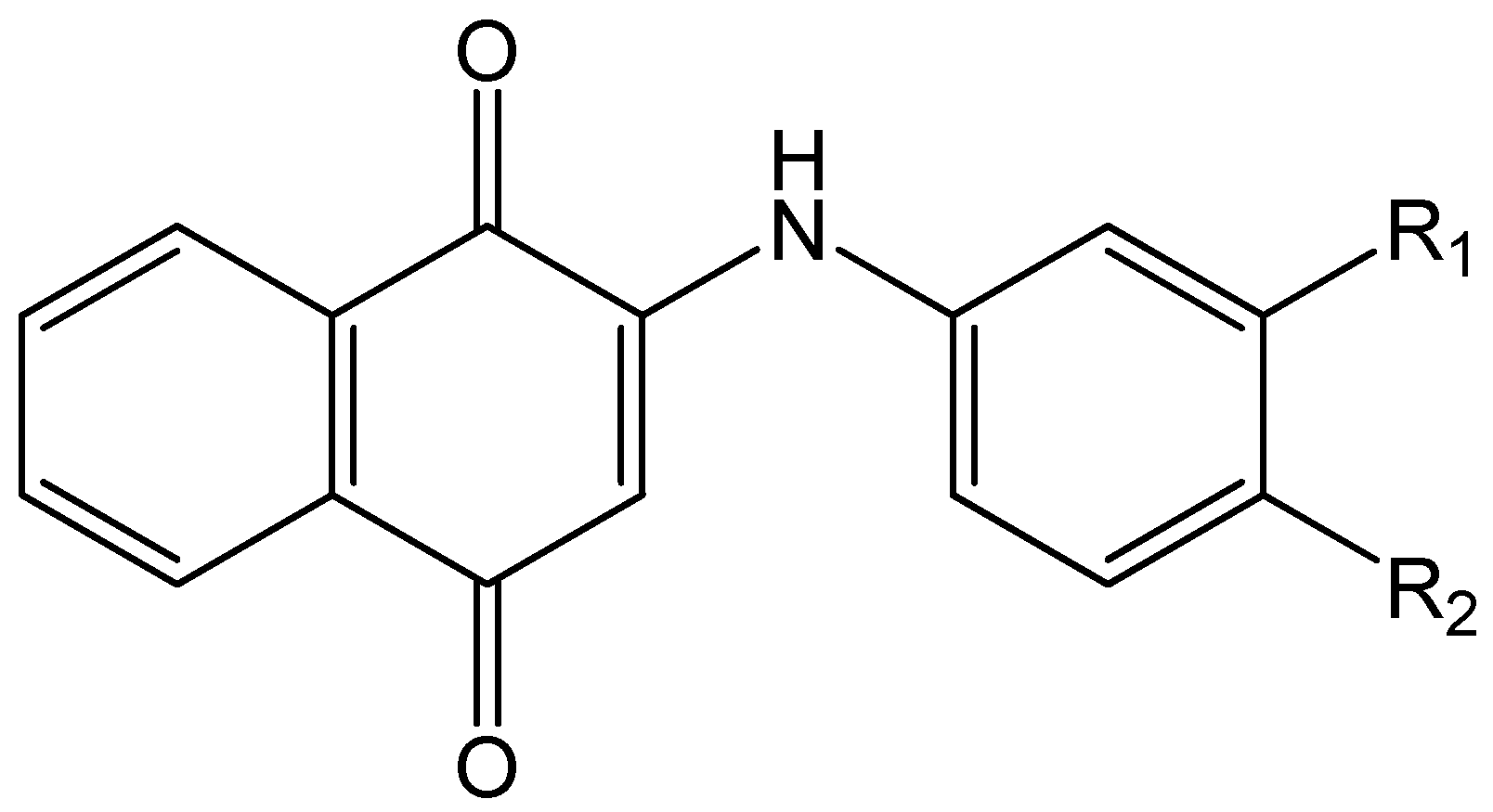
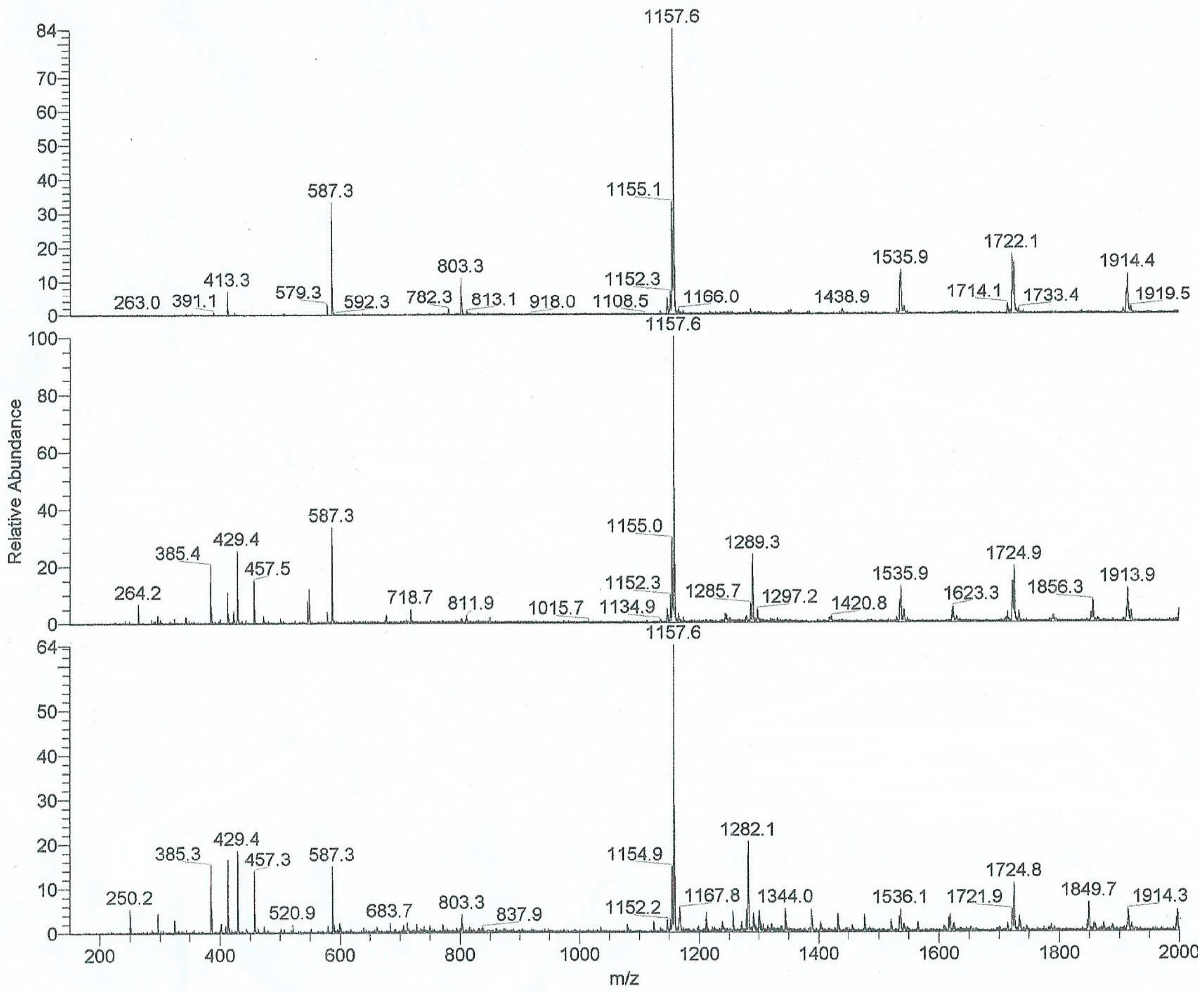
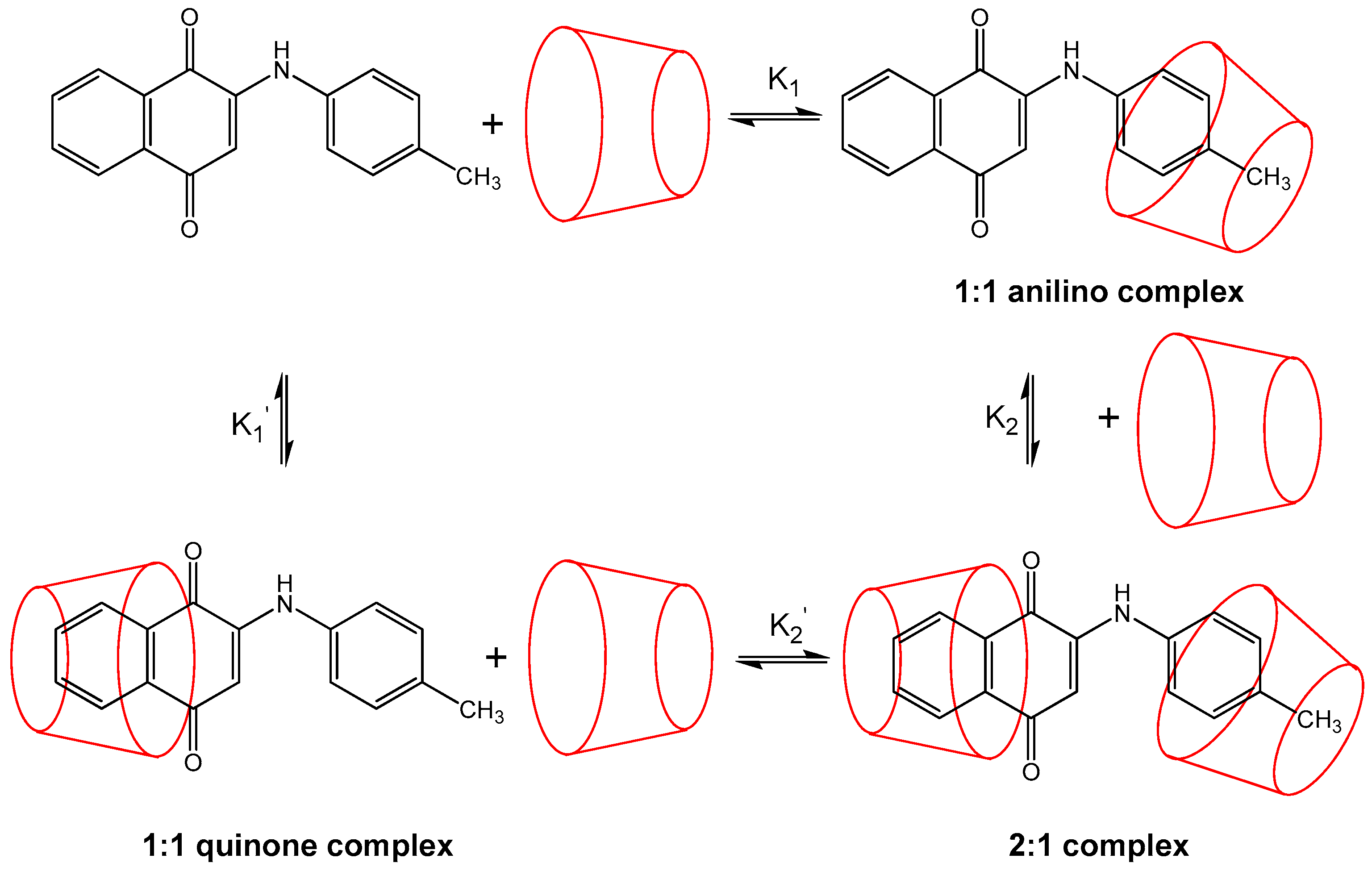
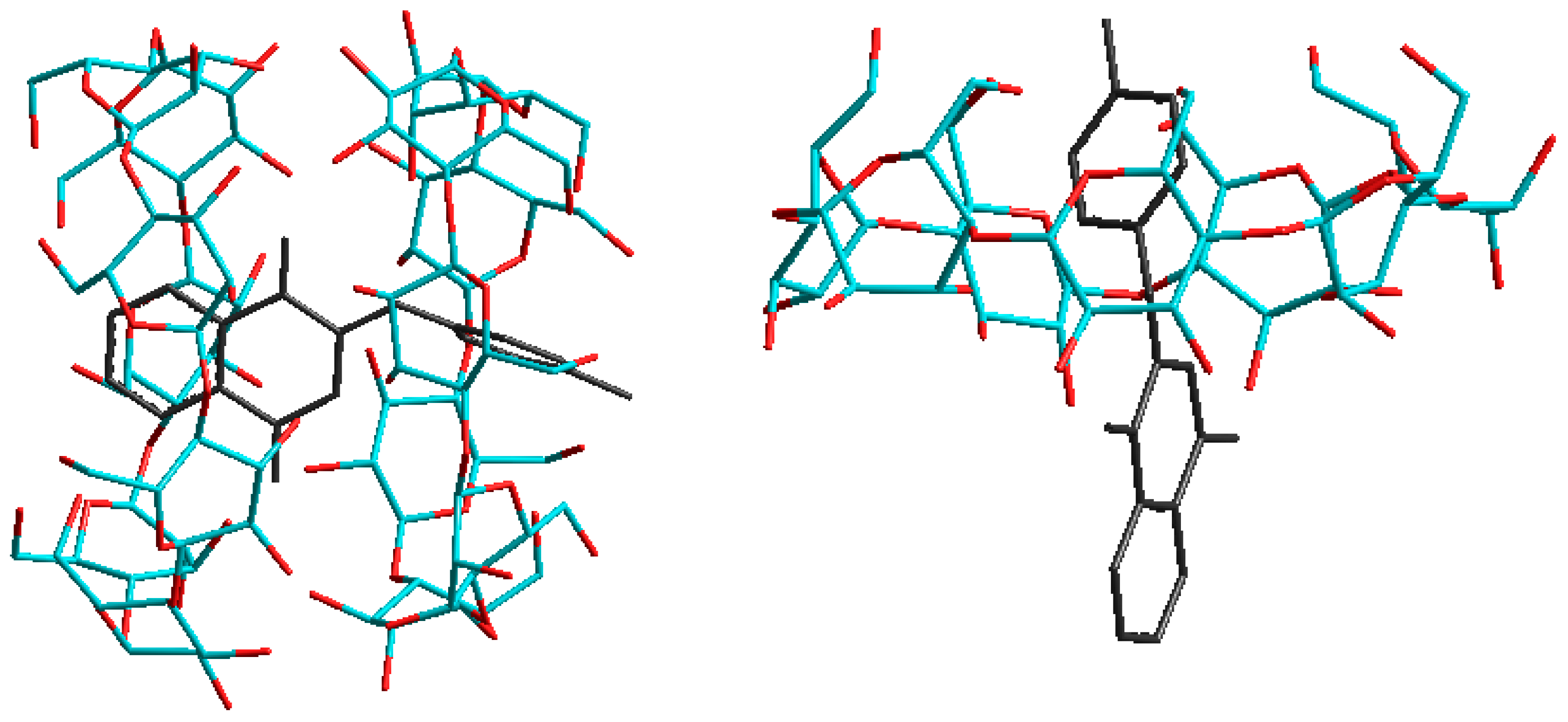
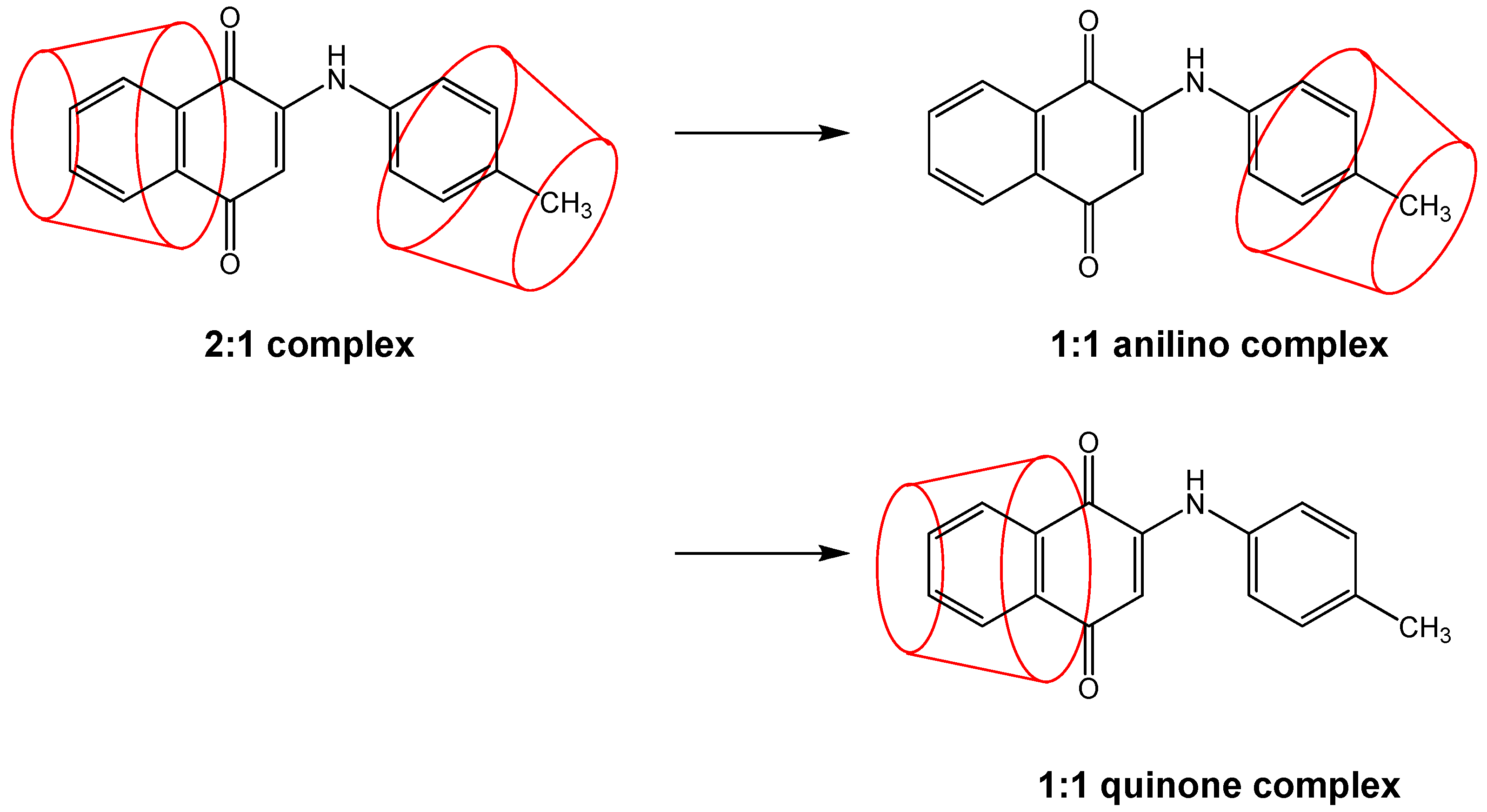
| Guest | R1 (meta) | R2 (para) | 1:1 β-CD | 2:1 β-CD | 1:1 γ-CD | 2:1 γ-CD |
|---|---|---|---|---|---|---|
| 1 | H | H | ✓ | ✓ | ✓ | ✕ |
| 2 | NO2 | H | ✓ | ✕ | ✓ | ✕ |
| 3 | H | OMe | ✓ | ✕ | ✓ | ✕ |
| 4 | Et | H | ✓ | ✓ | ✓ | ✕ |
| 5 | H | nBu | ✓ | ✕ | ✓ | ✕ |
| 6 | H | n-hexyl | ✓ | ✕ | ✓ | ✕ |
| 7 | Me | H | ✓ | ✓ | ✓ | ✓ |
| 8 | H | NO2 | ✓ | ✕ | ✓ | ✕ |
| 9 | H | Et | ✓ | ✕ | ✓ | ✕ |
| 10 | H | Me | ✓ | ✓ | ✓ | ✓ |
| 11 | CO2H | H | ✓ | ✕ | ✓ | ✕ |
| 12 | H | CO2H | ✓ | ✕ | ✓ | ✕ |
| 13 | H | CN | ✓ | ✕ | ✓ | ✕ |
| 14 | H | CF3 | ✓ | ✕ | ✓ | ✕ |
| 15 | Cl | H | ✓ | ✕ | ✓ | ✕ |
| 16 | H | Cl | ✓ | ✕ | ✓ | ✕ |
| 17 | H | Br | ✓ | ✕ | ✓ | ✕ |
| 18 | F | H | ✓ | ✕ | ✓ | ✕ |
| 19 | H | COCH3 | ✓ | ✕ | ✓ | ✕ |
| Guest | R1 (meta) | R2 (para) | ΔE 1:1 (Anilino) | ΔE 1:1 (Quinone) | ΔE 2:1 (Both Ends) |
|---|---|---|---|---|---|
| 1 | H | H | −19.82 | −21.77 | −31.37 |
| 2 | NO2 | H | −20.95 | −21.51 | −29.69 |
| 3 | H | OMe | −19.23 | −25.16 | −37.79 |
| 4 | Et | H | −20.99 | −22.80 | −33.73 |
| 5 | H | nBu | −30.04 | −21.51 | −48.26 |
| 6 | H | n-hexyl | −30.92 | −24.44 | −52.03 |
| 7 | Me | H | −31.09 | −28.71 | −40.63 |
| 8 | H | NO2 | −23.44 | −19.06 | −34.86 |
| 9 | H | Et | −22.61 | −20.61 | −49.07 |
| 10 | H | Me | −21.76 | −20.01 | −48.72 |
| 11 | CO2H | H | −23.07 | −22.41 | −31.10 |
| 12 | H | CO2H | −30.22 | −25.15 | −42.80 |
| 13 | H | CN | −24.3 | −16.43 | −39.65 |
| 14 | H | CF3 | −19.52 | −17.64 | −36.38 |
| 15 | Cl | H | −30.18 | −27.45 | −38.21 |
| 16 | H | Cl | −22.27 | −22.27 | −27.92 |
| 17 | H | Br | −30.43 | −28.66 | −54.34 |
| 18 | F | H | −27.23 | −27.94 | −44.17 |
| 19 | H | COCH3 | −23.61 | −22.16 | −34.70 |
| Guest | Stoichiometry | R1 (meta) | σm (R1) |
|---|---|---|---|
| 1 | 1:1 and 2:1 | H | 0 |
| 4 | 1:1 and 2:1 | Et | −0.07 |
| 7 | 1:1 and 2:1 | Me | −0.06 |
| 2 | 1:1 only | NO2 | 0.72 |
| 11 | 1:1 only | CO2H | 0.35 |
| 15 | 1:1 only | Cl | 0.37 |
| 18 | 1:1 only | F | 0.34 |
| Guest | Stoichiometry | R2 (para) | σp (R2) |
|---|---|---|---|
| 1 | 1:1 and 2:1 | H | 0 |
| 10 | 1:1 and 2:1 | Me | −0.14 |
| 3 | 1:1 only | OMe | −0.27 |
| 5 | 1:1 only | nBu | −0.16 |
| 6 | 1:1 only | n-hexyl | −0.16 |
| 8 | 1:1 only | NO2 | 0.78 |
| 9 | 1:1 only | Et | −0.15 |
| 12 | 1:1 only | CO2H | 0.44 |
| 13 | 1:1 only | CN | 0.66 |
| 14 | 1:1 only | CF3 | 0.53 |
| 16 | 1:1 only | Cl | 0.23 |
| 17 | 1:1 only | Br | 0.23 |
| 19 | 1:1 only | COCH3 | 0.50 |
| Guest | Stoichiometry | R1 (meta) | σm (R1) |
|---|---|---|---|
| 7 | 1:1 and 2:1 | Me | −0.06 |
| 1 | 1:1 only | H | 0 |
| 4 | 1:1 only | Et | −0.07 |
| 2 | 1:1 only | NO2 | 0.72 |
| 11 | 1:1 only | CO2H | 0.35 |
| 15 | 1:1 only | Cl | 0.37 |
| 18 | 1:1 only | F | 0.34 |
| Guest | Stoichiometry | R2 (para) | σp (R2) |
|---|---|---|---|
| 10 | 1:1 and 2:1 | Me | −0.14 |
| 1 | 1:1 only | H | 0 |
| 3 | 1:1 only | OMe | −0.27 |
| 5 | 1:1 only | nBu | −0.16 |
| 6 | 1:1 only | n-hexyl | −0.16 |
| 8 | 1:1 only | NO2 | 0.78 |
| 9 | 1:1 only | Et | −0.15 |
| 12 | 1:1 only | CO2H | 0.44 |
| 13 | 1:1 only | CN | 0.66 |
| 14 | 1:1 only | CF3 | 0.53 |
| 16 | 1:1 only | Cl | 0.23 |
| 17 | 1:1 only | Br | 0.23 |
| 19 | 1:1 only | COCH3 | 0.50 |
© 2016 by the authors. Licensee MDPI, Basel, Switzerland. This article is an open access article distributed under the terms and conditions of the Creative Commons Attribution (CC-BY) license ( http://creativecommons.org/licenses/by/4.0/).
Share and Cite
Jankowski, C.K.; Lamouroux, C.; Jiménez-Estrada, M.; Arseneau, S.; Wagner, B.D. Factors Affecting the Formation of 2:1 Host:Guest Inclusion Complexes of 2-[(R-Phenyl)amine]-1,4-naphthalenediones (PAN) in β- and γ-Cyclodextrins. Molecules 2016, 21, 1568. https://doi.org/10.3390/molecules21111568
Jankowski CK, Lamouroux C, Jiménez-Estrada M, Arseneau S, Wagner BD. Factors Affecting the Formation of 2:1 Host:Guest Inclusion Complexes of 2-[(R-Phenyl)amine]-1,4-naphthalenediones (PAN) in β- and γ-Cyclodextrins. Molecules. 2016; 21(11):1568. https://doi.org/10.3390/molecules21111568
Chicago/Turabian StyleJankowski, Christopher K., Christine Lamouroux, Manuel Jiménez-Estrada, Sebastien Arseneau, and Brian D. Wagner. 2016. "Factors Affecting the Formation of 2:1 Host:Guest Inclusion Complexes of 2-[(R-Phenyl)amine]-1,4-naphthalenediones (PAN) in β- and γ-Cyclodextrins" Molecules 21, no. 11: 1568. https://doi.org/10.3390/molecules21111568
APA StyleJankowski, C. K., Lamouroux, C., Jiménez-Estrada, M., Arseneau, S., & Wagner, B. D. (2016). Factors Affecting the Formation of 2:1 Host:Guest Inclusion Complexes of 2-[(R-Phenyl)amine]-1,4-naphthalenediones (PAN) in β- and γ-Cyclodextrins. Molecules, 21(11), 1568. https://doi.org/10.3390/molecules21111568







